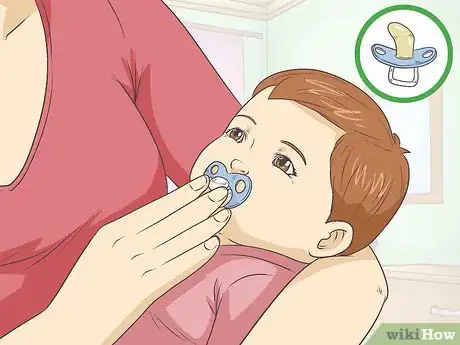This article was co-authored by Lisa Grossman, RN, BSN, PHN, IBCLC, CLC, CLEC and by wikiHow staff writer, Jessica Gibson. Lisa Grossman is a Lactation Consultant, Registered Nurse, and the Owner of South Bay Baby Care, a business focused on prenatal, breastfeeding, lactation, and CPR classes and services. Using years of experience working with mothers and babies, Lisa started South Bay Baby Care in 2018 with the goal of sharing her knowledge and expertise with expectant and new parents in the areas of newborn care, breastfeeding & lactation, sleep routines, postpartum care, and CPR + First Aid. Lisa holds a BSN from Mount St. Mary's University, is a board certified Registered Nurse (BRN RN-BSN), an International board certified Lactation Consultant (IBCLC), a Certified Lactation Counselor (ALPP), a Certified Lactation Educator Counselor (CLEC - UCSD), and a Member of the American Academy of Pediatrics (AAP).
There are 9 references cited in this article, which can be found at the bottom of the page.
This article has been viewed 28,515 times.
It's easy to feel frustrated and overwhelmed if your baby cries uncontrollably. These frequent crying episodes are known as colic. Fortunately, colicky babies are healthy; they just need extra comforting before they outgrow it. There are also things you can do to make breastfeeding a colicky baby easier. For example, let them nurse on demand and hold them frequently, even when they're not feeding. Your baby will feel comforted by knowing you're around and by the sound of your voice.
Steps
Adjusting Your Breastfeeding Techniques
-
1Feed your baby from one breast until the milk is gone. If your baby pulls off the breast and starts fussing, don't switch them to the other breast. Instead, keep them on the same breast and compress your breast a little to encourage them to keep feeding. The longer your baby nurses from the same breast, the more hindmilk they'll get.[1]
- Hindmilk is the milk your baby gets after feeding for a few minutes. It's rich in calories and fat, so it helps your baby feel full.
Tip: Try to relax and let your baby nurse as long as possible without timing the feeding session.
-
2Switch to the other breast if they're still hungry. You should alternate which breasts you nurse from so they don't become engorged or drop in milk supply. Once your baby has completely finished feeding from one breast, you can offer the other. If they only nurse from one breast during a session, start the next session with the opposite breast.[2]
- To help you remember which breast you fed from last, you can put a bracelet or hair tie around the wrist for that side. Switch the bracelet or hair tie to your other wrist after you've breastfed your baby from the other side.
Advertisement -
3Try several breastfeeding positions to see what your baby prefers. If you have overactive letdown and the milk comes out too quickly or forcefully for your baby, you can lie down on your side and lay your baby parallel to breastfeed. Your baby may also like it if you're laying flat on your back with them tummy-side down on top of you since this can slow the milk as it flows into their mouth.[3]
- If your baby is bothered by overactive letdown instead of colic, they'll usually start nursing just fine, but will begin to cough after a few seconds or a minute. Your baby might continue to struggle while nursing because the milk comes out too forcefully.
- Play around with positions until you can tell what your baby likes. For example, your baby might prefer to be held across your body or tucked against your side as they nurse.
EXPERT TIPRebecca Nguyen is a Certified Lactation Consultant and Childbirth Educator. She runs Family Picnic in Chicago, Illinois with her mother Sue Gottschall, where they teach new parents about childbirth, breastfeeding and child development and education. Rebecca taught preschool through 3rd grade for 10 years, and she received her Master’s Degree in Early Childhood Education from the University of Illinois in 2003.International Board Certified Lactation Consultant
 Rebecca Nguyen, MA
Rebecca Nguyen, MA
International Board Certified Lactation ConsultantDon't stress if you can't exclusively breastfeed. Lactation consultant Rebecca Nguyen says: "In the U.S., it's recommended that women exclusively breastfeed for the first 6 months, and to continue breastfeeding for up to a year or even longer. In reality, though, most people only make it a few months exclusively breastfeeding. If you're having trouble, a lactation consultant can help you figure out the best way to feed your baby."
-
4Feed your baby as soon as you notice their hunger cues.[4] If you wait until your baby is ravenous, they're already agitated and will be more likely to swallow air as they feed. This can make them gassy and uncomfortable. Instead, you should frequently give your baby the chance to breastfeed so they don't become irritated.
- Most 1 to 2-month-old babies need to breastfeed 7 to 9 times a day. As your baby gets older, they'll start consolidating some of these nursing sessions so you can go several hours between feedings.
- If you've waited until your baby is really hungry, they'll start whimpering, sucking, squirming, or rooting.
-
5Allow your baby to comfort feed. Try not to schedule feeds for your colicky baby since they may want to nurse just to be close to you. Don't worry if you recently fed the baby and they want to breastfeed again. The best thing you can do for your baby, in this case, is to cuddle them and keep them close so they feel comforted.
- Keep in mind that your baby might be breastfeeding a lot to build up your milk supply, especially if they're going through a growth spurt.
-
6Burp your baby frequently during and after feeding. Colicky babies tend to swallow a lot of air as they nurse, so it's important to burp them once or twice during feeding and then after they've finished nursing. Remember that you don't have to be forceful as you pat your baby's back. Instead, pat gently to release air trapped in their tummy.
- For a basic burping position, try holding the baby's tummy up against your shoulder and pat their back. You could also try laying your baby tummy-down across your legs while you support their head and pat their back.
Soothing Your Colicky Baby
-
1Hold or wear your baby as much as possible. Colicky babies love to be held and comforted so try to keep your baby close to you. They also like feeling snug, so consider swaddling the baby before you hold them. This is a great trick to try if your baby is waving their arms around as they cry.[5]
- Some colicky babies like being held with their tummy resting on your forearm. Use the palm of your hand to support their head and let their legs and arms hang on either side of your arm.
-
2Swing or bounce your baby to calm them. Movement can relax some colicky babies because it's similar to the gentle motion of being in the uterus before birth. Walk around your house while you slowly sway and swing the baby in your arms. You could also sit and rock with the baby or bounce them gently on your knee.[6]
- If you'd like to get out of the house and move around, put your baby in a stroller and go for a walk.
- Since young babies with colic usually aren't old enough to hold up their own heads, avoid putting them into bouncers.
- Never shake your baby to try to quiet them.
Tip: If you need to put your baby down, place it in a baby swing that will gently rock them. Some baby swings also play music that can soothe your baby.
-
3Talk or sing to your baby in a soothing voice. Your baby might relax or calm down when they hear you so speak to your baby in a soft voice. You can sing gentle lullabies or just talk to your baby about whatever you're doing.[7]
- Try to be a calm presence around your baby. They'll sense your peaceful attitude and may feel reassured.
-
4Offer your baby a pacifier. Some babies like to suck their fingers while others prefer sucking on a pacifier. Buy a pacifier according to your baby's age to ensure the nipple isn't too large for your baby's mouth. Put the pacifier in their mouth and hold it there for a few seconds. If your baby likes it, they'll begin to suck on it, but they may spit it out if they don't want it.[8]
- A small baby might have a hard time keeping a pacifier in their mouth, so you may need to pop it back in occasionally.
-
5Give your baby a warm bath in the evening. If you're trying to calm your colicky baby before putting them to sleep, help them relax. Put your baby into a baby bathtub with warm water and gently sponge them with the water to help them settle. You can also use lavender scented soap or lotion since some babies find this smell calming.[9]
- You can also fill a water bottle with warm water and place it on your baby's tummy. This can make them feel comfortable if they are gassy or have tummy trouble.
Getting Help
-
1Pay attention to how long your baby cries to determine if it's colic. Although there's no scientific way to diagnose colic, most doctors agree that a baby that cries for at least 3 hours a day for at least 3 days a week and for at least 3 weeks is colicky. If you suspect your baby has colic, they probably do, so don't hesitate to get some help.[10]
- Keep in mind that colic usually peaks when the baby is 6 to 8 weeks old.
-
2Talk with your doctor about starting an elimination diet. If you suspect that something you're eating is affecting your baby, ask your doctor's advice about eliminating specific foods from your diet. The doctor might tell you to cut out the food for at least 2 weeks in order to see if the food was irritating your baby. Common foods to eliminate include:[11]
- Dairy
- Eggs
- Wheat
- Peanuts
Tip: It's important to eliminate just one food at a time so you can monitor how it affects your baby.
-
3Get medical attention if your baby has a fever, bloody stools, or vomits. Most colicky babies simply cry, but if your baby is also vomiting, passing bloody stools, or has a fever of at least 100.4 °F (38.0 °C), you should get emergency medical attention since another condition could be bothering your baby.[12]
- If you can't reach your doctor, you may want to take your baby to urgent care or the emergency room, especially if the baby is less than 8 weeks old.
-
4Talk with the doctor about other conditions that can mimic colic. Keep in mind that other medical conditions could be making your baby uncomfortable which is why they're crying a lot. Ask your doctor to rule out:[13]
- Ear infection
- Urinary tract infection
- Reflux or gastroesophageal reflux (GER)
- Food allergies
- Hernia
- Intestinal obstruction
-
5Ask family or friends for extra support. It's not easy to care for a colicky baby, so ask your support network for some help. A friend might be able to sit with the baby while you get some rest or you can ask your partner to hold the baby while you shower or go for a walk. Remember that in order to care for your baby, you need to care for yourself.[14]
- Try to locate a lactation consultant or breastfeeding support group in your area. These are great resources that can offer you personalized help and advice.
Tip: If you feel too overwhelmed by the crying, set your baby down in a safe place and take a few deep breaths in another room.
References
- ↑ http://www.babycentre.co.uk/a549274/feeding-from-one-breast
- ↑ https://www.canadianbreastfeedingfoundation.org/basics/colic.shtml
- ↑ https://pathwaystofamilywellness.org/Breastfeeding/colic-in-the-breastfed-baby.html
- ↑ Lisa Grossman, RN, BSN, PHN, IBCLC, CLC, CLEC. International Board Certified Lactation Consultant. Expert Interview. 13 May 2020.
- ↑ https://www.parents.com/baby/care/colic/how-to-soothe-a-colicky-baby/
- ↑ https://www.parents.com/baby/care/colic/how-to-soothe-a-colicky-baby/
- ↑ https://raisingchildren.net.au/newborns/behaviour/crying-colic/colic-what-to-do
- ↑ https://www.clinicaladvisor.com/uncategorized/counseling-parents-with-colicky-babies/
- ↑ https://raisingchildren.net.au/newborns/behaviour/crying-colic/colic-what-to-do
- ↑ https://americanpregnancy.org/first-year-of-life/colic/
- ↑ https://www.canadianbreastfeedingfoundation.org/basics/colic.shtml
- ↑ https://myhealth.alberta.ca/Health/aftercareinformation/pages/conditions.aspx?hwid=ut1873
- ↑ https://americanpregnancy.org/first-year-of-life/colic/
- ↑ https://americanpregnancy.org/first-year-of-life/colic/










































































